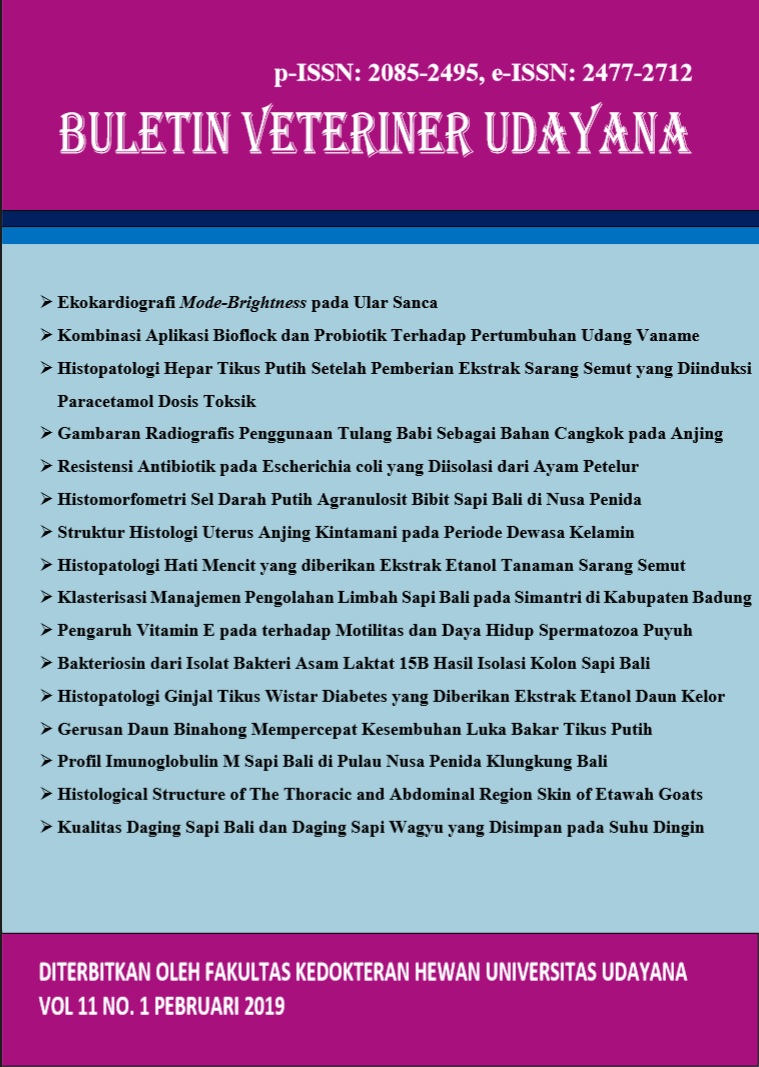THE CLUSTERING OF BALI CATTLES WASTE PROCESSING MANAGEMENT AT SIMANTRI IN BADUNG REGENCY
Abstract
This research aims were to find out the components of bali cattle waste processing that have not been intensively carried out and to find out which Gapoktan has not carried out an intensive Bali cattle processing system in Simantri Badung Regency. Sampling was done by saturated sampling technique, then the data obtained were analyzed using Hierarchical cluster with dendogram cluster plot with intensive, semi-intensive, and extensive identifying variables. The results of this study are the management components of waste processing which are mostly intensively treated by breeders, solid waste treatment, wastewater treatment, solid waste treatment technology, wastewater treatment technology, solid waste treatment equipment, liquid waste treatment equipment, waste management fostering, waste product marketing coaching. Onen housing management is still applied semi-intensively, namely the results of processing solid waste, the results of processing wastewater, the advantages of processing solid waste and the benefits of processing wastewater. The conclusion of this study is that from 50 Gapoktan in Simantri in Badung Regency, 42 Gapoktan already carry out intensive waste treatment, 6 Gapoktan that carry out semi-intensive waste treatment and 2 Gapoktan who do not carry out waste treatment or enter into an extensive category that needs to get counseling from the government so that everything becomes intensive.
Downloads
References
Agustina KK, Wirata IW, Dharmayudha AAGO. 2013. Prevalensi toxocara vitulorum pada induk dan anak sapi bali di wilayah Bali Timur. Bul. Vet. Udayana. 5(1): 1-6.
Agustina KK, Wirata IW, Dharmayudha AAGO, Kardena IM, Dharmawan NS. 2016. Increasing farmer income by improved pig management systems. Bul. Vet. Udayana. 8(2): 122-127.
Arumingtiyas WI, Fajriani S, Santosa M. 2014. Pengaruh aplikasi biourine terhadap pertumbuhan dan hasil tanaman padi. J. Prod. Tanaman. 2(8): 620-628.
Biro Humas Sekretaris Daerah Provinsi Bali. 2013. Data Informasi Program Pembangunan Pemerintah Provinsi. Denpasar.
Bhuanaputra KW, Yasa INM. 2017. Efektivitas dan Dampak Program SIMANTRI Terhadap Pendapatan dan Kesempatan Kerja Rumah Tangga Petani di Kecamatan Nusa Penida di Kabupaten Klungkung. E-J. Ekonomi Pembangunan. 6(5): 827-855
Dismawan IWH, Ginantra IK, Suriani NL. 2014. Seleksi Jenis Tumbuhan Pakan Dan Kandungan Nutrien Jenis Tumbuhan Yang Dimakan Sapi Bali (Bos Sondaicus) Lepas Sapih Di Daerah Bukit Badung Selatan, Kabupaten Badung, Bali. J. Simbiosis. 2(2): 192- 202.
Dinas Pertanian Tanaman Pangan Pemerintah Provinsi Bali. 2010. Kegiatan Sistem Pertanian Terintegrasi (Simantri) di Provinsi Bali. Denpasar.
Ginting N. 2007. Teknologi Pengolahan Limbahpeternakan. Fakultas Pertanian Universitas Sumatra Utara.
Sampurna IP, Nindhia TS, Sukada IM. 2017. Dendrogram Simulations with Determinatvariable Identifer to Determine the Farm Classification Systems of Bali Pigs. Int. J. Sci. Res. 6(10): 1602-1606.
Sanjaya IGAM. 2013. Efektifitas Penerapan Simantri dan Pengaruhnya terhadap Peningkatan Pendapatan Petani-Peternak di Bali. (disertasi). Denpasar: Universitas Udayana, Program Pascasarjana.
Sanjaya D, Haryanto A, Tamrin. 2015. Produksi biogas dari campuran kotoran sapi dengan kotoran ayam. J Teknik Pertanian Lampung. 4(2): 127-136.
Soehadji. 1992. Kebijaksanaan Pemerintah Dalam Pengembangan Industri Peternakan dan Penanganan Limbah Peternakan. Direktorat Jendral Peternakan Dapertemen Pertanian. Jakarta.
Sudita IDN, Mahardika IG, Suarna IW, Partama IBG. 2015. Analysis of Feed for Digestbility Bali Cow in Group Simantri Programing Bali on Different Topigraphic. Int. J. Adv. Sci. Eng. Info. Thec. 5(6): 495-500.
Suwiti NK, Besung INK, Mahardika GN. 2017. Factors influencing growth hormone levels of Bali cattle in Bali, Nusa Penida, and Sumbawa Islands, Indonesia. Vet. World. 10(10): 1250-1254.
Warsana. 2009. Pemantapan Kelembagaan pada Gapoktan. BPTP Jawa Tengah.





